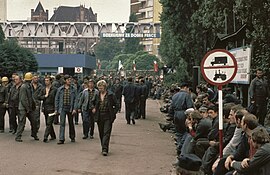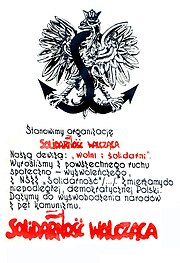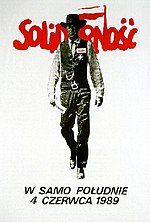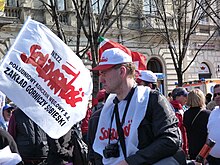History of Solidarity
The People's Republic of Poland attempted to destroy the union by instituting martial law on 13 December 1981, followed by several years of political repression but in the end was forced into negotiation.
[1] After a brief boom period, from 1975 the policies of the Polish government, led by Party First Secretary Edward Gierek, precipitated a slide into increasing depression, as foreign debt mounted.
[1] At the Lenin Shipyard in Gdańsk, the firing of Anna Walentynowicz, a popular crane operator and activist, galvanized the outraged workers into action.
[1][7] On August 14, the shipyard workers began their strike, organized by the Free Trade Unions of the Coast (Wolne Związki Zawodowe Wybrzeża).
[10] The Polish government enforced censorship, and official media said little about the "sporadic labor disturbances in Gdańsk"; as a further precaution, all phone connections between the coast and the rest of Poland were soon cut.
[1] Delegates (Bogdan Lis, Andrzej Gwiazda and others) together with shipyard strikers agreed to create an Inter-Enterprise Strike Committee (Międzyzakładowy Komitet Strajkowy, or MKS).
On August 21 a Governmental Commission (Komisja Rządowa) including Mieczysław Jagielski arrived in Gdańsk, and another one with Kazimierz Barcikowski was dispatched to Szczecin.
Though concerned with labor-union matters, the agreement enabled citizens to introduce democratic changes within the Communist political structure and was regarded as a first step toward dismantling the Party's monopoly of power.
[15] The workers' main concerns were the establishment of a labor union independent of Communist-party control, and recognition of a legal right to strike.
[17] Encouraged by the success of the August strikes, on September 17 workers' representatives, including Lech Wałęsa, formed a nationwide labor union, Solidarity (Niezależny Samorządny Związek Zawodowy (NSZZ) "Solidarność").
[18] It was the only time in recorded history that a quarter of a country's population (some 80% of the total Polish work force) had voluntarily joined a single organization.
"What we had in mind was not only bread, butter and sausages, but also justice, democracy, truth, legality, human dignity, freedom of convictions, and the repair of the republic.
The atmosphere was increasingly tense, with various local chapters conducting a growing number of uncoordinated strikes as well as street protests, such as the Summer 1981 hunger demonstrations in Poland, in response to the worsening economic situation.
[26] On December 13, 1981, Jaruzelski began a crack-down on Solidarity, declaring martial law and creating a Military Council of National Salvation (Wojskowa Rada Ocalenia Narodowego, or WRON).
[26] A couple of hundred strikes and occupations occurred, chiefly at the largest plants and at several Silesian coal mines, but were broken by ZOMO paramilitary riot police.
[28] The range of support for the Solidarity was unique: no other movement in the world was supported by Ronald Reagan, George H. W. Bush, Mikhail Gorbachev, Santiago Carrillo, Enrico Berlinguer, Pope John Paul II, Elizabeth II, Margaret Thatcher, Tony Benn, Polish Legion of American Veterans, Polish government-in-exile, Communist Polish Defectors, East Bloc Defectors, peace campaigners, NATO Spokesman, United Nations Spokesmen, Christians, Western Communists, Conservatives, Liberals, Socialists.
[34] In July 1983, martial law was formally lifted, though many heightened controls on civil liberties and political life, as well as food rationing, remained in place through the mid-to-late 1980s.
[41] It later transpired that the SB had prepared bogus documents, accusing Wałęsa of immoral and illegal activities that had been given to the Nobel committee in an attempt to derail his nomination.
[18] Frasyniuk, Lis and Adam Michnik, members of the "S" underground, were brutally beaten and arrested on February 13, 1985, starved, tortured, interrogated, placed on a trial, and sentenced to several years' imprisonment for committing several acts of terror against Polish state and its people.
[40] Following amnesty on September 30, Wałęsa created the first public, legal Solidarity entity since the declaration of martial law—the Temporary Council of NSZZ Solidarność (Polish: Tymczasowa Rada NSZZ Solidarność)—with Bogdan Borusewicz, Zbigniew Bujak, Władysław Frasyniuk, Tadeusz Janusz Jedynak, Bogdan Lis, Janusz Pałubicki and Józef Pinior.
[20] In the late 1980s, a rift between Wałęsa's faction and a more radical Fighting Solidarity grew as the former wanted to negotiate with the government, while the latter planned for an anti-Communist revolution.
There were no funds to modernize factories, and the promised "market socialism" materialized as a shortage economy characterized by long queues and empty shelves.
[18][40] On August 26, Czesław Kiszczak, the Minister of Internal Affairs, declared on television that the government was willing to negotiate, and five days later he met with Wałęsa.
Under Wałęsa's leadership, Solidarity decided to pursue a peaceful solution, and the pro-violence faction never attained any substantial power, nor did it take any action.
The Communists, led by General Jaruzelski, hoped to co-opt prominent opposition leaders into the ruling group without making major changes in the structure of political power.
As agreed beforehand, Wojciech Jaruzelski was elected president;[49][52] however, the Communist candidate for Prime Minister, Czesław Kiszczak, who replaced Mieczysław Rakowski,[49] failed to gain enough support to form a government.
Far from supporting Wałęsa, Solidarity was becoming increasingly critical of the government, and decided to create its own political party for action in the upcoming 1991 parliamentary elections.
A Solidarity call for new elections went unheeded, but the Sejm still managed to pass a resolution condemning the 1981 martial law (despite the SLD voting against).
[62] In June 1996, Solidarity Electoral Action (Akcja Wyborcza Solidarność) was founded as a coalition of over 30 parties, uniting liberal, conservative and Christian-democratic forces.
[64] In 2020, to commemorate the 40th anniversary of the creation of the Solidarity movement many important landmarks around the world were lit up in white and red colours including the Niagara Falls, Christ the Redeemer Statue, Széchenyi Chain Bridge in Budapest, Wrigley Building in Chicago, Qutb Minar in New Delhi with posters and Solidarity logos being displayed in cities such as Berlin, Dublin, NATO headquarters in Brussels, Belgrade and Santa Monica in California.










Solidarity Citizens' Committee election poster by Tomasz Sarnecki


